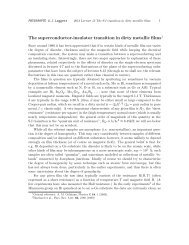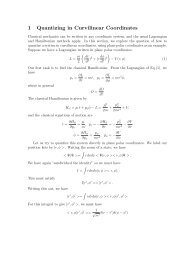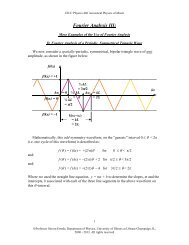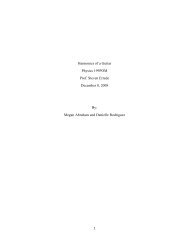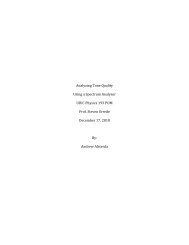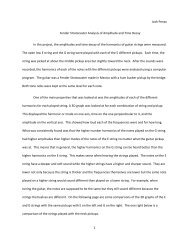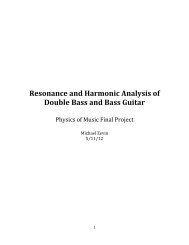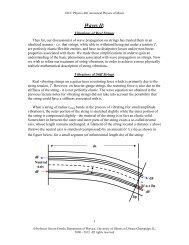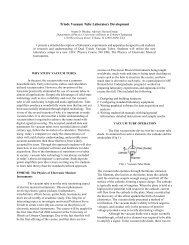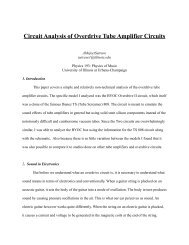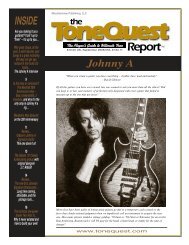Analysis of Different Materials for Trumpet Mouthpieces
Analysis of Different Materials for Trumpet Mouthpieces
Analysis of Different Materials for Trumpet Mouthpieces
Create successful ePaper yourself
Turn your PDF publications into a flip-book with our unique Google optimized e-Paper software.
<strong>Analysis</strong> <strong>of</strong> <strong>Different</strong><br />
<strong>Materials</strong> <strong>for</strong> <strong>Trumpet</strong><br />
<strong>Mouthpieces</strong><br />
Greg Formosa<br />
PHYS 199 - POM
INTRODUCTION<br />
• 3 <strong>Mouthpieces</strong> tested<br />
– C5 tuning note<br />
– A.k.a. Concert Bb4 - 466.164 Hz<br />
• Blessing 5C Mouthpiece<br />
– Metal (Original, Brass)<br />
– Plastic (Accura SI 40 RP)<br />
– Wood (Oak)
• Densities<br />
Gathered In<strong>for</strong>mation<br />
– Metal = brass ~67% copper, 33% zinc<br />
• 8.430-8.730 8.730 g/cm 3<br />
– Plastic = Accura SI 40<br />
• 1.1 g/cm 3<br />
– Wood = Oak<br />
• 0.590 – 0.930 g/cm 3
HYPOTHESIS<br />
• Less dense = more absorption<br />
– Lower amplitude/energy as density decreases<br />
– Less harmonics, more absorbed as density<br />
decreases<br />
– Frequencies similar*<br />
• Metal = “norm”<br />
• Plastic = similar<br />
• Wood = flat<br />
– Phase Differences<br />
• Plastic is similar to Metal<br />
• Wood has greater differences<br />
*Based on audible<br />
differences and<br />
general feel
Physical Differences<br />
• Audible Differences<br />
– Metal = brighter, more harmonics<br />
– Plastic = similar to metal, slightly less power<br />
– Wood = lower harmonics, less bright<br />
• Physical Differences (feel)<br />
– Metal = normal, smooth and easy to play<br />
– Plastic = similar, less heat transfer, harder to play<br />
higher<br />
– Wood = “stickier, stickier,” harder to control with lips, not<br />
smooth
5C Metal – Harmonic Amplitudes<br />
3x<br />
3x<br />
2.5x<br />
2<br />
x<br />
1.25x<br />
.5x
5C Wood – Harmonic Amplitudes<br />
4<br />
1.75x 1.63x<br />
1.25x 1.25x<br />
x<br />
.25x
5C Wood – Harmonic Amplitudes<br />
2x<br />
2. 2x<br />
2x<br />
3<br />
1.6x<br />
x<br />
.167x
Ratio <strong>of</strong> Harmonics to Fundamentals<br />
3<br />
2<br />
4<br />
WOOD<br />
METAL<br />
PLASTIC<br />
.167<br />
.167<br />
1.58<br />
1.58<br />
2<br />
2.2<br />
2.2<br />
2+<br />
2+<br />
Wood<br />
Wood<br />
.25<br />
.25<br />
1.25<br />
1.25<br />
1.25+<br />
1.25+<br />
1.63<br />
1.63<br />
1.75<br />
1.75<br />
Plastic<br />
Plastic<br />
.5<br />
.5<br />
1.25<br />
1.25<br />
2.5<br />
2.5<br />
3+<br />
3+<br />
3<br />
Metal<br />
Metal<br />
6th<br />
6th<br />
5th<br />
5th<br />
4th<br />
4th<br />
3rd<br />
3rd<br />
2nd<br />
2nd
PHASE DIFFERENCES<br />
• 2 nd harmonic very similar – 125-135 135 degrees<br />
• 4 th and 6 th harmonics <strong>of</strong> plastic slightly out <strong>of</strong><br />
phase<br />
• 3 rd and 5 th harmonics closer in phase <strong>for</strong> plastic
• Wood Mpc. . Phase:<br />
– Very skewed phases<br />
– Extremely high degree out <strong>of</strong> phase (25,000)<br />
– No similar aspects to other mpc. . Phases
5C Metal – Normalized Amplitude
5C Plastic – Normalized Amplitude
5C Wood – Normalized Amplitude
Normalized Amplitudes<br />
• Metal and plastic similar, like relative<br />
phases graphs<br />
• Plastic is slightly out <strong>of</strong> phase compared to<br />
metal, but a little skewed<br />
• Wood 2 nd harmonic is very similar to metal<br />
and plastic<br />
– All others (3, 4, 5, 6) are skewed and bent<br />
towards 0, between -30 and 30 degrees
FREQUENCIES<br />
• Graphs all similar, hard to differentiate<br />
• Inconclusive data<br />
• By ear: (compared to metal)<br />
– Plastic sounded a bit flat<br />
– Wood sounded a bit sharp
CONCLUSIONS<br />
• Harmonics & energies stay generally the same<br />
regardless <strong>of</strong> material or density<br />
– Plastic’s s 2 nd harmonic is bigger than normal, unaudible difference<br />
though<br />
• As density decreases, the 3 rd -5 th (strong) harmonics<br />
move closer to fundamental, less out <strong>of</strong> phase<br />
• Also as density decreases, 2 nd harmonic moved more<br />
and more out <strong>of</strong> phase, away from fundamental<br />
– Unaudible differences in phase, except maybe to trained ears<br />
• Biggest difference is due to texture and rigidity to player<br />
– The difference between mouthpieces to a musical listener is<br />
minute, but to the player is great.



